A Report on Vocational Training in Chicago and in Other Cities
Chapter 2: The Need of Chicago Schools for Industrial Education
Table of Contents | Next | Previous
INDUSTRIAL EDUCATION IN CHICAGO AND IN OTHER CITIES
BY
ERNEST A. WREIDT
Special Investigator for the Subcommittee
This chapter presents a consideration of the need for industrial education in Chicago as shown (a) by the elimination of pupils from school, (b) by the number of over-age or retarded children in the elementary grades, and (c) by facts relating to children not in school between the ages of fourteen and sixteen years.
Manual training and industrial training
A distinction is made throughout this report between manual training and industrial training, in the sense that the latter aims primarily and definitely at preparation for industrial vocations, whereas the former aims at the general education of the individual, through the hand, whatever his vocation is to be.
In presenting the need for industrial training it is not the purpose of this report to minimize the value of manual training, as such, in the public schools. The two kinds of training, as defined above, are not antagonistic. Even though some phases of the actual tradework done in present industrial schools may be introduced into manual training courses, to vitalize and enrich those courses, they may still remain general in character, and may operate for the general education of the individual, without regard to the specific vocation he is to follow. The term industrial training, however, is reserved for those courses which lay definite hold upon the vocational motive of pupils, which give more time to handwork than manual training courses give, and which sooner or later provide specialized and intensive training for industrial pursuits.
(29)
It is, then, the purpose of this chapter to show that the vocational motive should be introduced into the school by way of industrial courses, to assist in retaining pupils longer under school influence, to help arouse the interest and further the progress of retarded or over-age pupils, and to reduce the waste incident to the years fourteen to sixteen in the case of children who leave school at fourteen. The grades in which the greatest need exists for industrial courses will also be pointed out.
Elimination of pupilsThe enrolment statistics of the Chicago schools, for the year 1310, show (Fig. 1) that of `the number of pupils entering the first grade only 57 per cent were in the eighth grade, 30 per cent in the first year of high school, and only 6 per cent in the last year.
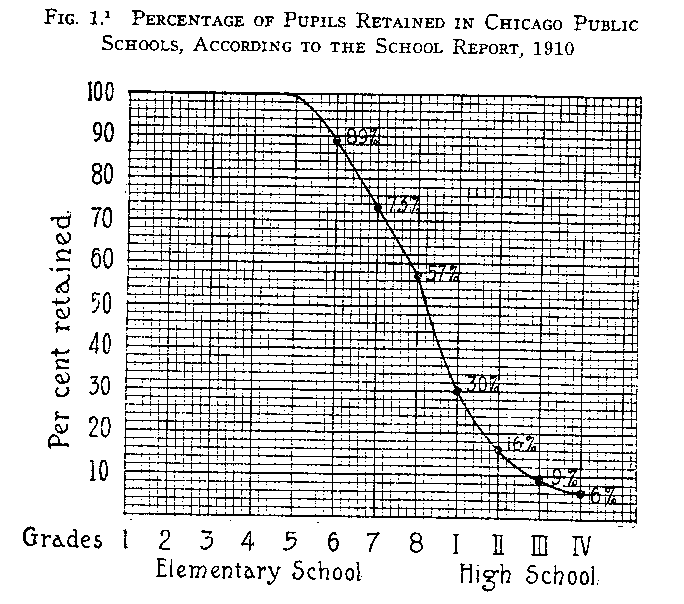
30)
Fig. 1 shows, in other words, that 43 per cent of the pupils who entered the first grade did not reach the eighth grade, 27 per cent did not reach the seventh grade, 11 per cent did not reach the sixth grade, and 94 per cent did not complete the high-school course.[2]
Since only 86 per cent of the 57 per cent enrolled in grade eight were promoted to the high school[3], the number who completed grade eight in 1910 was only 49 per cent of the number who entered grade one.
The largest gap between two successive grades is the gap between the eighth grade and the first year of high school, 27 per cent of the pupils dropping out at this point. In an effort to bridge this gap the Board of Education has recently provided two-year vocational courses for the first two years of the high school. It is quite evident from the above figures, however, that these vocational courses, with graduation from the eighth grade as a prerequisite, do not meet the greatest need of the schools as shown by the dropping out of pupils, for 43 per cent of the pupils leave school before reaching the eighth grade. The greatest need for vocational courses to hold pupils in school is apparently in grades 6, 7 and 8, which is the field occupied by the Farragut Elementary Industrial School.
The Chicago schools are neither much worse nor much better than the schools of other cities with respect to the percentage of pupils retained.[4] In general it is charged that the large percentage of elimination indicates that the schools are not suited to the abilities and interests of most of the pupils. The following statements give further evidence of this condition in Chicago schools.[5]
(1) The average pupil in the first five grades progresses at the rate of eight grades in 10.4 years.
(2) Over 69,000 pupils (32 per cent of the total) in elementary schools are one year or more behind grade.[6] This retardation is greatest in grades 4, 5 and 6.
(3) Over 36,000 pupils in elementary schools (17.4 per cent of the total) repeat the work of a grade one or more times.[7]
31)
(4) The money cost of this repetition is over $1,300,000.[8]
(5) There is 15 per cent more retardation among boys than among girls; there are 23 per cent more repeaters among boys than among girls; and the percentage of girls in grade 1 who enter the eighth grade is 15 per cent greater than the percentage of boys.
| Grade | One year or more over-age | 2 years or more over-age | 3 years or more over-age | 4 years or more over-age | |
|---|---|---|---|---|---|
| Number | Per cent | ||||
| 1 | 5,697 | 14.8 | 2,050 | 976 | 549 |
| 2 | 7946 | 26.1 | 3,417 | 1,542 | 835 |
| 3 | 11340 | 34.6 | 5,146 | 2,451 | 1,091 |
| 4 | 11,878 | 41.7 | 5,995 | 2,547 | 740 |
| 5 | 12,426 | 46.5 | 5,890 | 1,855 | 403 |
| 6 | 9,598 | 43.8 | 3,608 | 855 | 135 |
| 7 | 6,144 | 34.2 | 1,841 | 326 | 43 |
| 8 | 4,064 | 27.4 | 1,001 | 156 | 25 |
| Total. | 69,093 | 32.7 | 28,948 | 10,708 | 3,821 |
32)
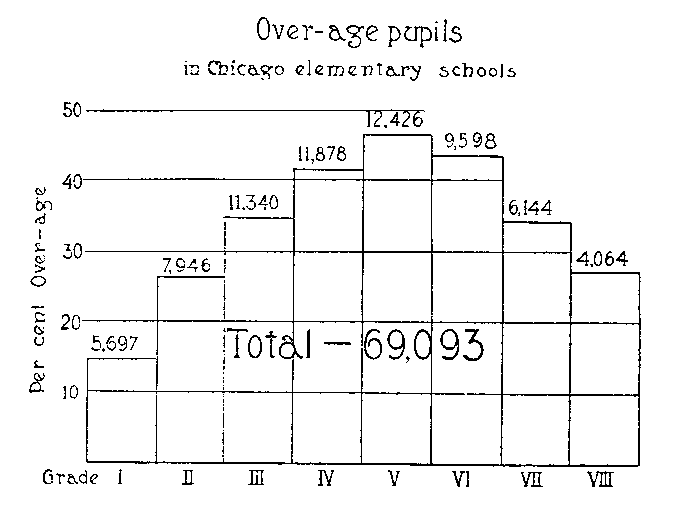
It is evident from the facts given that the Chicago schools give the training of the eight grades to about half of the children who enter. It is not safe to assume that most of the children who leave school before completing the eighth grade do so because parents can not afford to keep them in school. This assumption is frequently made, tacitly or explicitly, but it is not supported by sufficient evidence. Indeed, the evidence that exists [see pages 3i, 38] indicates that very likely most of these children leave school because the school does not provide the kind of training needed. Since the instruction in the lower grades is not suited to the abilities and interests of the average child, about half drop out at the age of fourteen, having lost a year or more since entering. It is evident also that instruction in the grades is better suited to the needs of the girls than to those of the boys.
The large number of over-age children in grades 4, 5 and 6 points to the importance of introducing vocational courses in the elementary grades. These retarded children are the ones most likely to drop out to go to work when they reach the compulsory age limit of fourteen years. The elimination begins, as shown in Fig. 1, in grade 6. Special vocational courses beginning below grade 6 should
(33) therefore be of service in arousing the interest of the retarded pupils and in retaining them in school.
The "wasted years," fourteen to sixteen
The need for industrial education is closely associated with the problem of the " wasted years " of childhood, between fourteen and sixteen, when, as is shown below, large numbers leave school to go to work, although these years in the industries offer little by way of financial compensation, or byway of vocational training and advancement. Wide interest has been aroused in educational circles by the statement of this problem as made in the report of the Massachusetts Commission on Industrial Education, 1906.
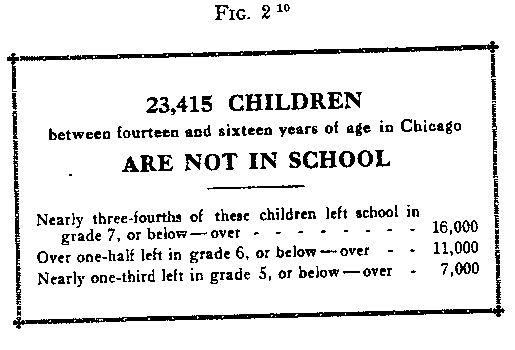
Fig. 2 reveals conditions in Chicago, with respect to these years, even worse than those presented in the Massachusetts report. In Massachusetts the number of children between fourteen and sixteen years of age who were not in school was about 25,000, which is about seven-tenths of one per cent of the total population of the State," whereas the 23,415 children in Chicago represent 1.1 per cent of the population of the city.[12] The Chicago children also, before leaving school, have not reached so high a grade as the Massachu-
34)
-setts children.[13] Only one-fourth of the 23,415 children not in school in Chicago had received eighth-grade training, and only four per cent had been in high school.[10]
What becomes of these children in Chicago? Over half of them (11,750) were idle-neither in school nor at work-according to the census enumerators (Table 5). The rest were stated to be at work, 36 per cent (4.223) in miscellaneous occupations, 29 per cent (3,384) in factories, and 34 per cent (4,058) in stores and offices. However, a simple bit of reasoning shows that if half of these children were idle when the census was taken [14] the chances are that the average child works only half the time between fourteen and sixteen years of age. Stated in other words, the average boy or girl who leaves school at fourteen years of age is doomed to one year of idleness in the first two years out of school.
| TABLE 5.15 POPULATION BETWEEN FOURTEEN AND SIXTEEN YEARS | ||
| OF AGE IN CHICAGO | ||
| Number | Per cent | |
| Not in school | ||
| Idle | 11,750 | 14.6 |
| At work | 11,665 | 14.4 |
| Total | 23,415 | 29.0 |
| In school | ||
| Public | 43,415 | 53.9 |
| Private | 13,636 | 16.9 |
| Total | 57,051 | 70.8 |
| Total population Between 14 and 16 | 80,466 | .......... |
35)
All of these children left school to go to work, but they find the industrial field already flooded with juvenile workers. Very few are wanted in the skilled industries, to learn a trade, until they are sixteen or eighteen years of age.[16] The State law specifically prohibits more than twenty occupations to these children and limits their working day to eight hours. They have little or no manual skill to offer the employer and they have received very little school training (Fig. 3). Employers in all grades of industry show an increasing aversion to employ children under sixteen years of age.[17]
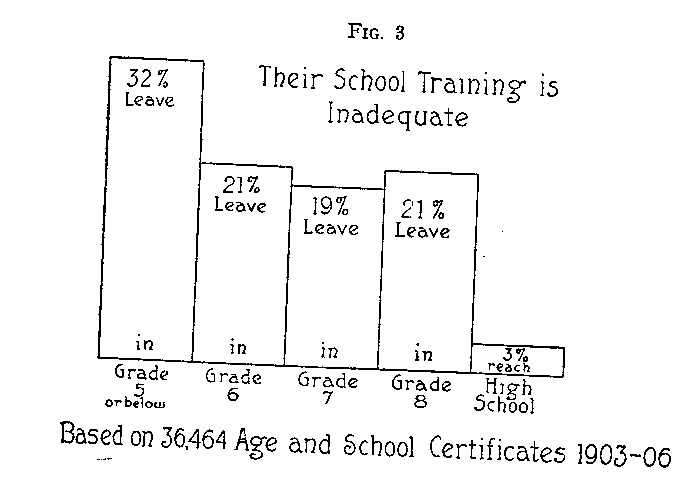
The Massachusetts investigation bears out the statement that most of these children flit about from one juvenile occupation to another, with intermittent idleness for weeks at a time, all of which serves to develop " that unsteadiness of purpose, irresponsibility of character,
(36) and irregularity of habit which is the undoing of manhood and womanhood."
GRADE |
1903-1906 | 1908-1909 | ||
|---|---|---|---|---|
| No. | Per cent | No. | Per cent | |
| From grade 5[19], and below | 11,803 | 32.3 | 3,630 | 28. 9 |
| From grade 6 | 7,716 | 21.1 | 2,579 | 20.6 |
| From grade 7 | 6,984 | 19.1 | 2,433 | 19.4 |
| Total below grade 8 | 26,503 | 72.6 | 8,642 I | 68.9 |
| From grade 8 | 7,660 | 21.0 | 2,278 | 18.1 |
| From high school | 1,370 | 3.7 | 770 | 6.1 |
| Evening schools and unclassified | 931 | 2.6 | 848 | 6.7 |
| Total certificates issued . . | 36,464 | . . . . . . . . | 12,538 | . . . . . . . . . . |
The eagerness with which children leave school to go to work is shown in the fact that of the 12,538 children receiving age certificates in 1908-9, 3,259 or 25.9 per cent were not more than 14 years 1 month of age, and 6.660 children, or 53.1 per cent were not over 14 years 6 months of age.[20] These children do not wait long to leave school after they become old enough to go to work.
That few children return to school after receiving age certificates is shown by an investigation of 16,672 children holding certificates. Of this number only 2,947, or 17 per cent were in school,[21] apparently compelled to return to school by the attendance officers who found the children neither in school nor at work.
On page 277 of this report it is estimated that boys between fourteen and sixteen years of age in Chicago earn on the average about $4.25 a week. The United States census of manufacturers for 1905
(37) shows that boys and girls between fourteen and sixteen in the manufacturing industries of Chicago earn an average of $195 a year, less than $4 a week. These wages are for the time the children are at work, but, as stated before, the chances are that the average child works only half the time during these years, which reduces his earning power to about $2 a week for the period.
Why, then, do these children leave school? When this question was asked of 205 boys in connection with the investigation reported on page 277, over 90 per cent said they were tired of school and could have remained in school so far as their financial circumstances were concerned. Fully 75 per cent said they would have continued in school if trade instruction had been offered.
The Massachusetts investigation, covering 5.423 children and 3.157 families, disclosed the following interesting facts with reference to children between fourteen and sixteen years of age who were not in school :[22]
76 per cent of the families were financially able to give industrial
school training to their children;
66 per cent of the children could have continued in school had they
wanted to;
55 per cent of the families declared they would send their children to
trade schools, if such schools should be provided.
Still further evidence that many pupils who leave the public school would be attracted by distinctly vocational training may be found in the large number enrolled in correspondence and other private vocational schools conducted as business undertakings for profit. Fig. 4 gives an estimate of the enrolment and the amount of tuition paid in private commercial and industrial schools located in Chicago and conducted for profit. The figures given do not include the enrolment of Chicago students in correspondence schools, or in Y.M.C.A. and parochial schools.
(38)
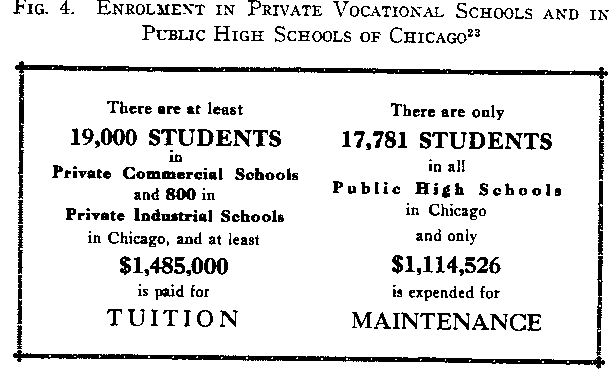
The large number of students who are willing to pay for instruction in these private schools shows in a convincing way the strong demand for practical training in commercial and industrial pursuits. It is shown in Chapters X and XIII that a large number of children leave the public high and elementary schools of Chicago to enter private business colleges. In the case of students from other cities an additional cost for living expenses is, of course, involved.
That a year or more in the ordinary school would be of value to the children who leave at the age of fourteen is shown by tests in practical arithmetic, English, etc., given to 655 boys who left school in grades from the high school down to the sixth grade.[24] These tests, while showing a deplorable deficiency in most of the boys, nevertheless exhibit a consistent superiority of the upper grade boy over the boy from the next lower grade.
But the ordinary school, as shown by the statistics given, does not attract and hold. the majority of the children until they have completed the eighth grade. That intermediate industrial schools and courses, giving definite and practical preparation for vocations, would attract large numbers, may be easily inferred from the facts which have been presented. That employers and organized labor
(39) in Chicago would welcome such schools for children between fourteen and sixteen years of age is shown in Fig. 5.
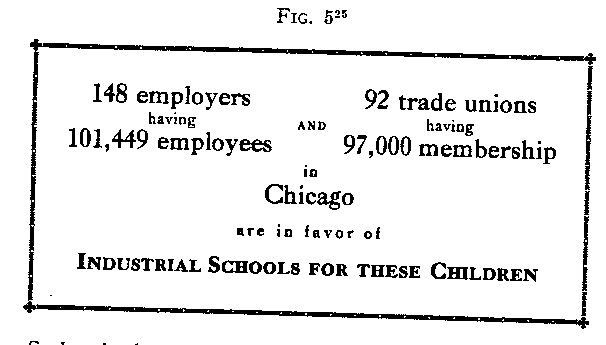
Such schools and courses, if they are to attract pupils and parents, and if they are to win the confidence of employers and workmen, should be distinctly and frankly practical in their aim and work, not excluding, however, academic instruction closely related to industrial needs. Experiments in other cities present the three following types of schools and courses which have been developed in an effort to meet this need.[26]
1. Optional industrial courses in grades 6 to 8, inclusive, parallel to existing grammar school courses, and not interfering with graduation from the elementary school in the usual time.
2. Industrial schools and courses for elementary school pupils thirteen to fifteen years of age, which do not offer the possibility of graduation in the usual time.
3. Independent industrial schools, offering trade training of a preparatory kind to children fourteen to sixteen years of age from grade 6, or above.
Conclusions
The opinion is common in educational circles that the eight grades of the elementary school represent the minimum school training that should be required of all children not incapacitated by
(40) nature for receiving that training. It is indeed humiliating when one realizes that only half of the children in the public schools of Chicago receive this minimum. Those who leave school with less than this minimum enter the industries under the handicap of an insufficient school training. The first two years out of school for those who leave at fourteen are at present largely wasted, both to the child and to the industries - to the child because he finds little or no opportunity for training or advancement in the industries, because he receives little or no general training of a beneficial kind and may be subject to much harmful influence incident to idleness and shifting occupation; to the industries because children are not prepared to take positions as trained workers when they are old enough to do skilled work. But these years could be made of great value for school training along vocational lines, and there are good reasons for believing that many children who now leave school at fourteen could be retained in school by such training.
To the school is thus presented the opportunity to extend its influence over a portion of the community not hitherto reached. By appealing to the vocational motive, the school may provide that training in skill which the industries themselves no longer adequately provide,[27] and it may at the same time continue the general education of the children on the academic side by quickening their intelligence and interest in the active life they are to enter.
Whatever may be the cause, the fact remains that large numbers of children leave school at various points in the course. The school can hardly be considered as doing its lull duty, as a social institution, unless it provides for each pupil, before he leaves school, that training which best fits him for the life he is to enter. The conditions and needs of the life he is to enter must be studied by the school, and a curriculum should be provided which does not assume that all pupils will take the complete course and go on through college, but which offers at various appropriate points finishing courses which prepare definitely for a life career.
It should be clear, from the statistics given, that the greatest need for such finishing courses, and for vocational courses to hold pupils in school, is in the intermediate grades, for the years twelve to sixteen. Technical education in the high school is, of course, important, but it does not reach the large number of children who never
(41) enter the high school, but who enter the industries under the handicap of an insufficient school training. It is much more important that all children should receive the equivalent of an eighth grade training than that a few more than at present should enter the high school.
Industrial training of an introductory or rudimentary kind should begin at the age of twelve or thirteen, in whatever grades the children of that age may be found, in order to reach them before they have an opportunity to leave school. Such industrial courses, from two to four years in length, should serve as finishing courses for those who must enter the industries at an early age. It is the distinctive opportunity of the high school, and therefore its duty, to take advantage of the superior academic attainments of its pupils by training mainly for positions above that of the actual mechanic, for the directive positions in the industries. Such technical courses in the high school, if they are true finishing courses preparing definitely for a life career after high school, should be of service in retaining in the high school many pupils who now leave before completing the course. On the lower academic levels the industrial courses should provide for the actual mechanic of the future the training in skill which is needed in the industries, and should give as much of the technical instruction in applied science, mathematics, knowledge of materials, etc., as the academic attainments of the pupils will permit. Such elementary courses should give that all-around training in skill which is not generally obtainable in the industries, and should endeavor to develop such a degree of industrial intelligence and adaptability as will make rapid advancement possible after work is begun.